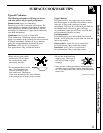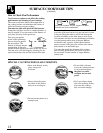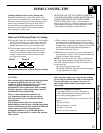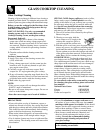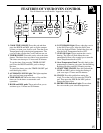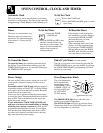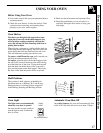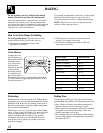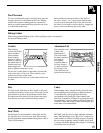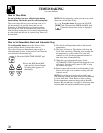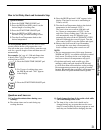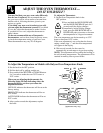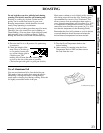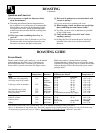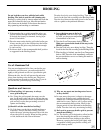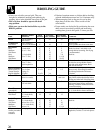
Baking
Pan Placement
For even cooking and proper browning, there must be
enough room for air circulation in the oven. Baking
results will be better if baking pans are centered as
much as possible rather than being placed to the front
or to the back of the oven.
Pans should not touch each other or the walls of
the oven. Allow 1- to 1
1
⁄
2
-inch space between pans
as well as from the back of the oven, the door and
the sides. If you need to use two shelves, stagger the
pans so one is not directly above the other.
Baking Guides
When using prepared baking mixes, follow package recipe or instructions
for the best baking results.
Cookies Aluminum Foil
When baking
cookies, flat cookie
sheets (without
sides) produce
better-looking
cookies. Cookies
baked in a jelly roll
pan (short sides all
around) may have
darker edges and
pale or light browning may occur.
Do not use a cookie sheet so large that it touches the
walls or the door of the oven. Never entirely cover
a shelf with a large cookie sheet.
For best results, use only one cookie sheet in the oven
at a time.
Never entirely cover
a shelf with
aluminum foil.
This will disturb
the heat circulation
and result in
poor baking.
A smaller sheet of
foil may be used
to catch a spillover
by placing it on a
lower shelf several
inches below the food.
Pies Cakes
For best results, bake pies in dark, rough or dull pans
to produce a browner, crisper crust. Frozen pies in foil
pans should be placed on an aluminum cookie sheet
for baking since the shiny foil pan reflects heat away
from the pie crust; the cookie sheet helps retain it.
When baking cakes, warped or bent pans will cause
uneven baking results and poorly shaped products.
A cake baked in a pan larger than the recipe
recommends will usually be crisper, thinner and
drier than it should be. If baked in a pan smaller than
recommended, it may be undercooked and batter may
overflow. Check the recipe to make sure the pan size
used is the one recommended.
Don’t Peek
Set the timer for the estimated cooking time and do
not open the door to look at your food. Most recipes
provide minimum and maximum baking times such as
“bake 30-40 minutes.”
DO NOT open the door to check until the minimum
time. Take advantage of the “Big View” window (on
some models) to monitor cooking progress. Opening
the oven door frequently during cooking allows heat
to escape and makes baking times longer. Your baking
results may also be affected.
19



